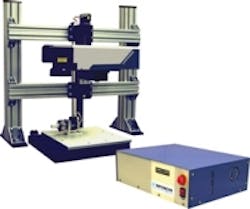Permanent marking on stainless steels
Santa Clara and Monrovia, Calif. – Stainless steels are well-suited for making medical instruments: it is easy to clean and sterilize, strong and corrosion-resistant. The composition of the steel provides these properties: chromium resists scratches and corrosion, nickel provides a smooth and polished finish, and molybdenum gives greater hardness and helps maintaining a cutting edge. A requirement exists to permanently mark such instruments.
Fiber laser marking of stainless steel a) SS304 and b) 17-7.
The challenge for laser marking in this application is to create a visible mark without compromising the corrosion resistance of the material. In practice, this requires that the surface of the material does not become molten and that the mark is produced by building up an oxide layer that becomes visible and enriched with chromium to maintain corrosion resistant properties. This can be achieved by careful optimization of the process parameters, producing a dark surface mark with good contrast and no surface damage. The mark is created by the build-up of a surface oxide layer and by control of its thickness marks of different colors can be produced.
Pulsed fiber lasers show a good potential to make dark oxide marks on stainless steel medical tools. Corrosion resistant marking on SS304 and 17-7 has been proven, but 17-4 presents more of a challenge and requires further investigation. Pulse repetition rates between 200 and 500 KHz appear to provide the key to corrosion resistant marking and also offer improved marking speed and throughput. Modeling the mark process provides an insight into heat input and aids in determining marking parameters.
This article, written by Hongqiang Chen and Mark Brodsky at SPI Lasers, Santa Clara, Calif., and Geoff Shannon at Miyachi Unitek, Monvoria, Calif., is from the Winter 2011 Issue of the AILU Magazine.

